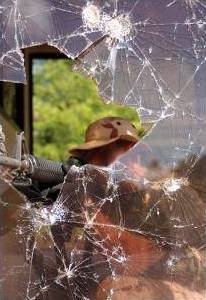

If you’re in the front line, in the danger zone, ducking bullets from all directions, you need all the help you can get. No-one can move fast enough to dodge a sniper’s bullet, when they can’t even see it coming. There’s only one way to protect yourself: place a barrier in front of your body that will dissipate a bullet’s energy. That’s the basic idea behind bulletproof glass. Let’s take a look at how it works!


Photo: Normal glass offers little protection against bullets. When a bullet strikes a pane of glass, the bullet’s energy pushes against the glass, making fractures radiate out from the point where the bullet hit along lines of weakness. This is what makes glass shatter into huge shards. Glass damaged like this adds an extra element of danger: if the bullet doesn’t kill you, the glass just might. Picture by Bennie J. Davis III courtesy of the US Air Force.
If you’ve ever caught a fast-moving baseball or cricket ball, you’ll know the trick is to move your hand back and stop the ball gradually so you reduce its energy very slowly. That reduces the force on your hand so the catch hurts less. Putting it more scientifically, the force the ball exerts on your hand is equal to the rate at which the ball’s momentum changes. So if you change its momentum slowly, by bringing it to a halt gradually, the force you feel is reduced. Let’s say you stop a ball nearly instantly in half a second and you feel a hefty smack as your hand absorbs the impact. Now suppose you could replay the moment and take two seconds to stop the ball instead. This time, taking four times longer to bring the ball to rest, your hand would feel only quarter as much force—so the ball would hurt you much less.
Unlike your hand, a piece of glass can’t move. If someone fires a bullet at an ordinary piece of glass, the glass can’t bend and absorb the energy very gradually. So it simply shatters and the bullet carries on through with hardly any loss of momentum. That’s why ordinary glass offers no protection against bullets: it is completely ineffective at slowing them down and absorbing their energy.
How bulletproof glass works

“Bulletproof” glass is very different to ordinary glass. More correctly called bullet-resistant glass (because no glass is totally bulletproof), it’s made from multiple layers of tough glass with “interlayers” of various plastics. Sometimes, there’s a final inner layer of polycarbonate (a tough type of plastic) or plastic film to prevent “spalling” (where dangerous shards of glass or plastic splinter off following the impact of a bullet). This sandwich of layers is called a laminate. It can be up to ten times thicker than a single pane of ordinary glass and it’s usually very heavy.
When a bullet strikes bulletproof glass, its energy spreads out sideways through the layers. Because the energy is divided between a number of different pieces of glass and plastic, and spread over a large area, it is quickly absorbed. The bullet slows down so much that it no longer has enough energy to pierce through—or to do much damage if it does so. Although the glass panes do break, the plastic layers stop them flying apart. Think of bulletproof glass as “energy-absorbing” glass and you’ll have a good idea how it works.
Where is bulletproof glass used?
Bulletproof glass comes in all shapes and sizes to give different levels of protection in different situations. You’re most likely to find it in places like banks, where the tellers typically sit behind thick bulletproof windows and use bulletproof drawers to exchange paperwork and money with customers. Generally speaking, the thicker the glass and the more layers it has, the more energy it can absorb and the more protection it will give. Basic bulletproof glass ranges from about 3cm (1.185 in) to 4cm (1.59 in) thick, but it can be made twice this thick if necessary.
The only problem is, the thicker you make bulletproof glass the heavier it becomes. That may not be a problem in a bank, but it’s certainly a consideration when you’re trying to bulletproof a president’s car or a “Popemobile”. Making bulletproof glass thicker also makes it slightly more opaque, because light struggles to get through all those extra layers. That can cause difficulties if it impairs the driver’s visibility. Rap artist Buster Rhymes ran into problems in 2007 when police stopped his SUV (with its 5cm/2in-thick bulletproof glass) “for having excessively tinted windows” (only 70 percent light transmission).
With MC Ballistics bulletproof partition systems. we manufacture glass panels in all sort of different sizes as it fit our clients fit and need.
All rights reserved by MC BALLISTICS